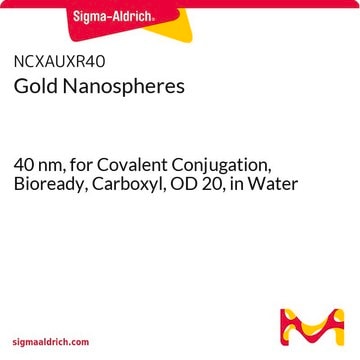推薦產品
材料
PEG 5000
形狀
dispersion in H2O
nanoparticles
包裝
poly bottle of 1 mL
外徑
50
直徑
30 nm
pH值
6.0-8.0 (25 °C)
溶解度
water: miscible
密度
1.00 g/cm3
λmax
525 nm
官能基
carboxylic acid
儲存溫度
2-8°C
尋找類似的產品? 前往 產品比較指南
一般說明
Gold nanoparticles (AuNPs) ranging from 2-200nm in diameter find applications in diverse fields. They show excellent biocompatibility and attractive physicochemical properties. Poly (ethylene) glycol (PEG) surface coatings on gold nanoparticles help in the reduction of protein adsorption, reduce nonspecific interactions with cells and greatly improve the pharmokinetics of these nanoparticles and reduce aggregation of the nanoparticles. PEG layer density depends inversely on the AuNP curvature. Denser coating was possible on smaller AuNPs. Carboxylic acid functionalized GNPs form conjugates with various protein molecules due to the electrostatic attraction between the negatively charged carboxylate groups and positively charged amino groups of protein. Since it adheres to cell membranes, it may find use in cellular and intracellular targeting in targeted drug delivery applications and also used in biodistribution studies.[1][2][3]
應用
Several other specific applications have been listed below:
- Since they adhere to cell membranes, AuNPs may find use in cellular and intracellular targeting in targeted drug delivery applications and may also be used in biodistribution studies.
- AuNPs may also be used in photothermal therapy and radiotherapy.
- AuNPs ranging from 10 to 250 nm, were studied to have been absorbed primarily by liver and spleen, when injected intravenously in rats.Whereas, 10 nm nanoparticles were distributed more broadly into various organs.
- Carboxylic acid end-groups binds with various proteins and hence are used in targeted drug delivery and gene therapy.[1][2][3][6]
儲存類別代碼
12 - Non Combustible Liquids
水污染物質分類(WGK)
WGK 1
閃點(°F)
Not applicable
閃點(°C)
Not applicable
客戶也查看了
Nishima Wangoo et al.
Journal of colloid and interface science, 323(2), 247-254 (2008-05-20)
We report a novel strategy for the synthesis of aqueous stable, carboxylated gold nanoparticles (GNPs) by using glutamic acid as the reducing agent. The ratio of chloroaurate ions, AuCl(-)(4) to glutamic acid was optimized in the reaction medium to obtain
Xiao-Dong Zhang et al.
International journal of nanomedicine, 6, 2071-2081 (2011-10-07)
Gold nanoparticle toxicity research is currently leading towards the in vivo experiment. Most toxicology data show that the surface chemistry and physical dimensions of gold nanoparticles play an important role in toxicity. Here, we present the in vivo toxicity of
Timothy A Larson et al.
ACS nano, 6(10), 9182-9190 (2012-09-27)
Polyethylene glycol (PEG) surface coatings are widely used to render stealth properties to nanoparticles in biological applications. There is abundant literature on the benefits of PEG coatings and their ability to reduce protein adsorption, to diminish nonspecific interactions with cells
Functionalized gold nanoparticles and their biomedical applications
Tiwari, P. M., Vig, K., Dennis, V. A., & Singh, S. R.
Nanomaterials, 1(1), 31-63 (2011)
文章
最近出现的许多高功能纳米材料为癌症的认识、诊断和治疗提供了新的方案。
The recent emergence of a number of highly functional nanomaterials has enabled new approaches to the understanding, diagnosis, and treatment of cancer.
Biomaterials science integrates smart materials into biological research, requiring a deep understanding of biological systems.
Active Filters
我們的科學家團隊在所有研究領域都有豐富的經驗,包括生命科學、材料科學、化學合成、色譜、分析等.
聯絡技術服務






